Slipped Disc / Herniated Disc

Slipped Disc is most often the result of a gradual, ageing related wear and tear called disk degeneration. It is also known as Herniated Disc or Disc Prolapse.
Our spinal column is comprised of a series of bones, also called vertebrae, which is stacked onto each other. The spinal column is divided into 5 segments with total 33 vertebrae.
- Cervical (neck) – 7 vertebrae (C1 to C7)
- Thoracic (middle back) – 12 vertebrae (T1 to T12)
- Lumbar (lower back) – 5 vertebrae (L1 to L5)
- Sacrum – 5 vertebrae (S1 to S5)
- Coccyx (tailbone) – 4 fused vertebrae.
These bones are protected by discs. They absorb the shocks to the bones caused from our daily activities. The disc is comprised of two parts, a tough outer ring and a soft gelatinous inner portion. The most common causes of slipped disc are weakness and injury. Weakness resulting from a gradual, ageing related wear and tear or injury to the disc can cause the inner portion to protrude through the outer ring. This is called herniated disc, also known as slipped disc or prolapsed disc.
A slipped disc or herniated disc can occur in any part of the spine, though the lower back is often the most common site for slipped discs.
Symptoms of Slipped Disc
A slipped disc can cause pain and discomfort to the patient. If the spinal nerves get compressed, it can also cause numbness and pain around the affected nerve.
Symptoms of slipped disc include:
- Pain and numbness (common on one side of the body)
- Pain worsened at night
- Pain extending to arms or legs
- Pain with sitting, standing, certain movements, or even walking short distances.
- Weakness in the muscle
Slipped Disc Treatment Options
Non-Surgical Treatment
- Oral Medications
- Steroid Injections
- Physiotherapy
Surgical Treatment
- Minimally Invasive Spine Surgery (MISS)
- Endoscopic Discectomy
- Microscopic Discectomy
Minimally Invasive Spine Surgery (MISS)
Minimally Invasive Spine Surgery is a surgical treatment option for patients suffering with slipped disc. MISS, as the name suggests, is a surgery to the bones of the spine, which is performed using smaller incisions. Hence the term minimally invasive. The benefit of minimally invasive procedure is less pain and faster recovery. In contrast, open surgery requires a long incision down the back.
Endoscopic Discectomy
Endoscopic Discectomy is a surgical procedure for treating herniated disc. It is performed to remove the herniated disc material from the disc which is compressing the nerve or the spinal cord. This is also a minimally invasive procedure, as only a small incision is necessary since it is performed with the aid of an endoscope.
The benefits of Endoscopic Discectomy include
- Short recovery time
- Small Incision
- Outpatient procedure (can be discharged on the same day)
- Minimal blood loss
Microscopic Discectomy
Microscopic Discectomy is also performed to remove the herniated disc material from the disc, which is compressing the nerve or the spinal cord. This technique also uses a small, minimally invasive incision to remove the disc herniation. This allows for a speedy recovery.
Doctors for Herniated Disc Treatment at Keyhole Clinic
Dr. Sudish Karunakaran is one of the Best Spine Surgeons in Kochi with expertise in Minimally Invasive Spine Surgery and in treating complex Brain and Spine Disorders.
- Conditions
- Tags: Neurosurgery






